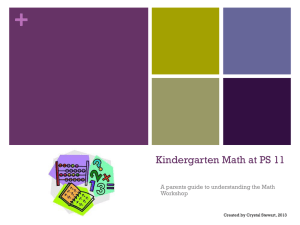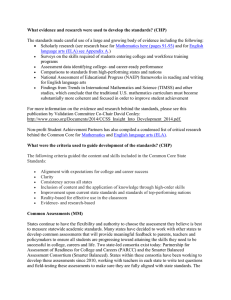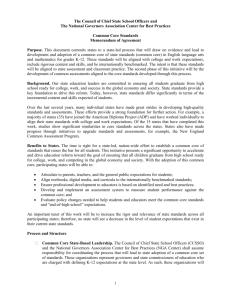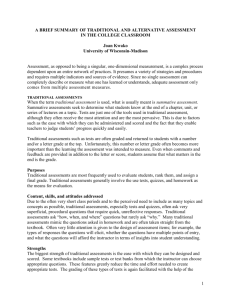What Parents Should Know About the Common Core Standards
advertisement
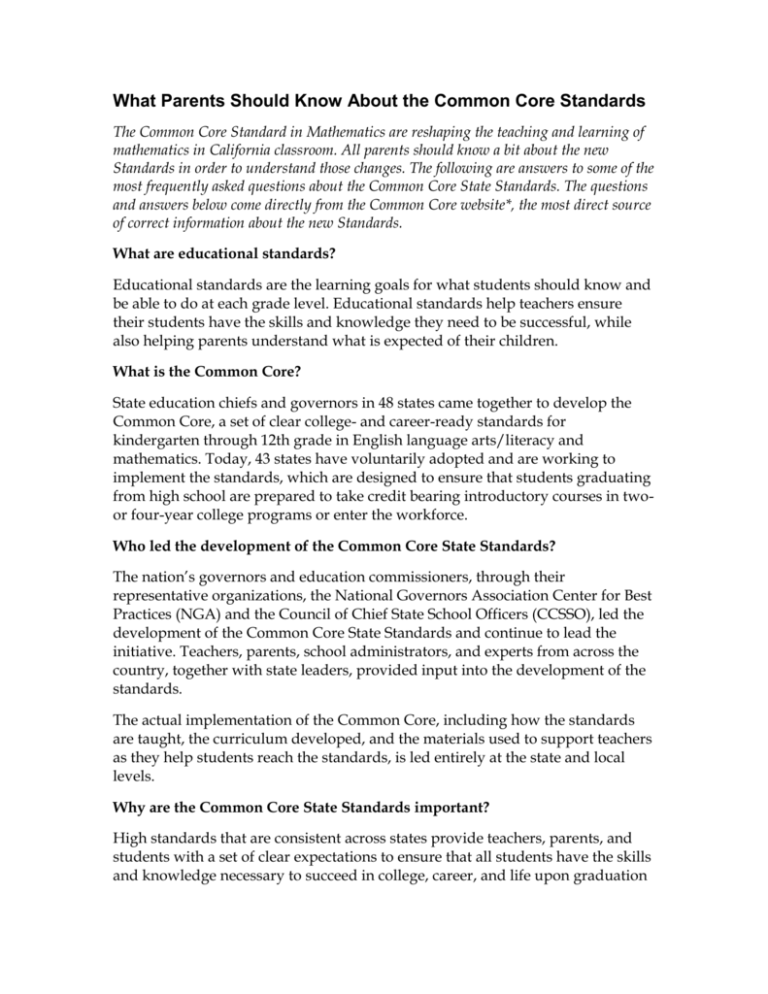
What Parents Should Know About the Common Core Standards The Common Core Standard in Mathematics are reshaping the teaching and learning of mathematics in California classroom. All parents should know a bit about the new Standards in order to understand those changes. The following are answers to some of the most frequently asked questions about the Common Core State Standards. The questions and answers below come directly from the Common Core website*, the most direct source of correct information about the new Standards. What are educational standards? Educational standards are the learning goals for what students should know and be able to do at each grade level. Educational standards help teachers ensure their students have the skills and knowledge they need to be successful, while also helping parents understand what is expected of their children. What is the Common Core? State education chiefs and governors in 48 states came together to develop the Common Core, a set of clear college- and career-ready standards for kindergarten through 12th grade in English language arts/literacy and mathematics. Today, 43 states have voluntarily adopted and are working to implement the standards, which are designed to ensure that students graduating from high school are prepared to take credit bearing introductory courses in twoor four-year college programs or enter the workforce. Who led the development of the Common Core State Standards? The nation’s governors and education commissioners, through their representative organizations, the National Governors Association Center for Best Practices (NGA) and the Council of Chief State School Officers (CCSSO), led the development of the Common Core State Standards and continue to lead the initiative. Teachers, parents, school administrators, and experts from across the country, together with state leaders, provided input into the development of the standards. The actual implementation of the Common Core, including how the standards are taught, the curriculum developed, and the materials used to support teachers as they help students reach the standards, is led entirely at the state and local levels. Why are the Common Core State Standards important? High standards that are consistent across states provide teachers, parents, and students with a set of clear expectations to ensure that all students have the skills and knowledge necessary to succeed in college, career, and life upon graduation from high school, regardless of where they live. These standards are aligned to the expectations of colleges, workforce training programs, and employers. The standards promote equity by ensuring all students are well prepared to collaborate and compete with their peers in the United States and abroad. Unlike previous state standards, which varied widely from state to state, the Common Core enables collaboration among states on a range of tools and policies, including the: Development of textbooks, digital media, and other teaching materials Development and implementation of common comprehensive assessment systems that replace existing state testing systems in order to measure student performance annually and provide teachers with specific feedback to help ensure students are on the path to success Development of tools and other supports to help educators and schools ensure all students are able to learn the new standards How do the Common Core State Standards compare to previous state education standards? The Common Core was developed by building on the best state standards in the United States; examining the expectations of other high-performing countries around the world; and carefully studying the research and literature available on what students need to know and be able to do to be successful in college, career, and life. No state was asked to lower their expectations for students in adopting the Common Core. The evidence-based standards were developed in consultation with teachers and parents from across the country, so they are also realistic and practical for the classroom. What makes this process different from other efforts to create common standards? From the very beginning, the process of developing the Common Core has been bipartisan and state led. It also has support from educators, policymakers, and business leaders across the country, including CCSSO, the NGA Center, Achieve, Inc., ACT, the College Board, the National Association of State Boards of Education, the Alliance for Excellent Education, the Hunt Institute, the National Parent Teacher Association, the State Higher Education Executive Officers, the American Association of School Administrators, the U.S. Chamber of Commerce, and the Business Roundtable. What evidence and criteria were used to develop the standards? The standards made careful use of a large and growing body of evidence, including: Scholarly research Surveys on the skills required of students entering college and workforce training programs Assessment data identifying college- and career-ready performance Comparisons to standards from high-performing states and nations Findings from Trends in International Mathematics and Science (TIMSS) and other studies, which conclude that the traditional U.S. mathematics curriculum must become substantially more coherent and focused in order to improve student achievement What do the Common Core State Standards mean for students? Today’s students are preparing to enter a world in which colleges and businesses are demanding more than ever before. To ensure all students are prepared for success after graduation, the Common Core establishes a set of clear, consistent guidelines for what students should know and be able to do at each grade level in math and English language arts. Do the standards tell teachers what to teach? Teachers know best about what works in the classroom. That is why these standards establish what students need to learn, but do not dictate how teachers should teach. Instead, schools and teachers decide how best to help students reach the standards. Will common assessments be developed? Two state-led consortia, Partnership for Assessment of Readiness for College and Careers (PARCC) and the Smarter Balanced Assessment Consortium (Smarter Balanced), are currently working to develop assessments that aim to provide meaningful feedback to ensure that students are progressing toward attaining the necessary skills to succeed in college, career, and life. These assessments are expected to be available in the 2014-2015 school year. Most states have chosen to participate in one of the two consortia. For more information, visit the website of your state’s assessment consortium. Two additional consortia, working through the National Center and State Collaborative Partnership and the Dynamic Learning Maps Alternative Assessment System Consortium, are developing a new generation of assessments for students with the most significant cognitive disabilities. Will the National Governors Association Center for Best Practices and the Council of Chief State School Officers (who led the development of the Common Core State Standards) be creating common instructional materials and curricula? No. The standards are not curricula and do not mandate the use of any particular curriculum. Teachers are able to develop their own lesson plans and choose materials, as they have always done. States that have adopted the standards may choose to work together to develop instructional materials and curricula. As states work individually to implement their new standards, publishers of instructional materials and experienced educators will develop new resources around these shared standards. Do the Common Core State Standards incorporate both content and skills? In mathematics, the standards lay a solid foundation in whole numbers, addition, subtraction, multiplication, division, fractions, and decimals. Taken together, these elements support a student’s ability to learn and apply more demanding math concepts and procedures. The middle school and high school standards call on students to practice applying mathematical ways of thinking to real-world issues and challenges. Across the English language arts and mathematics standards, skills critical to each content area are emphasized. In particular, problem-solving, collaboration, communication, and critical-thinking skills are interwoven into the standards. *http://www.corestandards.org/about-the-standards/frequently-asked-questions/




